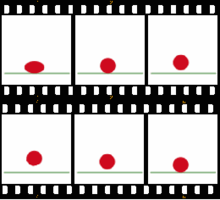Portal:Animation

| Main | Categories and topics | Tasks and projects |
Introduction
Animation is a filmmaking technique by which still images are manipulated to create moving images. In traditional animation, images are drawn or painted by hand on transparent celluloid sheets (cels) to be photographed and exhibited on film. Animation has been recognized as an artistic medium, specifically within the entertainment industry. Many animations are computer animations made with computer-generated imagery (CGI). Stop motion animation, in particular claymation, has continued to exist alongside these other forms.
Animation is contrasted with live-action film, although the two do not exist in isolation. Many moviemakers have produced films that are a hybrid of the two. As CGI increasingly approximates photographic imagery, filmmakers can easily composite 3D animations into their film rather than using practical effects for showy visual effects (VFX). (Full article...)
Selected article
Sideshow Bob is a recurring character in the animated television series The Simpsons. He is voiced by Kelsey Grammer (pictured) and first appeared briefly in the episode "The Telltale Head". Bob is a self-proclaimed genius who is a graduate of Yale, a member of the Republican Party, and a champion of high culture. He began his career as a sidekick on Krusty the Clown's television show, but after enduring constant abuse, Bob attempted to frame his employer for armed robbery in "Krusty Gets Busted". The plan was foiled by Bart Simpson, and Sideshow Bob was sent to prison. Bob made his second major appearance in season three's "Black Widower". In each appearance thereafter, Bob has assumed the role on The Simpsons of an evil genius. Episodes in which he is a central character typically involve Sideshow Bob being released from prison and executing an elaborate revenge plan, usually foiled by Bart and Lisa. His plans often involve murder and destruction, usually targeted at Bart or, less often, Krusty, though these plans often involve targeting the entire Simpson family. Sideshow Bob shares some personality traits of Grammer's character Frasier Crane from the sitcoms Cheers and Frasier, and has been described as "Frasier pickled in arsenic". As of 2012, Bob has had speaking appearances in thirteen episodes and been featured in eleven; the most recent of the latter, "The Bob Next Door", aired during the twenty-first season.
Selected image
Did you know (auto-generated) -

- ... that the Tuca & Bertie episode "The Jelly Lakes" employs a paper-cutout animation that helps to depict abuse in a way that centers the victim's story?
- ... that the creators of the cartoon Jade Armor filmed live-action martial arts stunts to visualize the show's animated action sequences?
- ... that at age 12, Shaylee Mansfield became the first deaf actor to be credited alongside the voice actors for a signed performance in an animated production?
- ... that, for the animated film Us Again, director and writer Zach Parrish considered a video of an elderly couple dancing to be visceral and ideal inspiration?
- ... that Raoul Servais invented a new technique for combining animation and live action for his short film Harpya?
- ... that the Pakistani film Shehr e Tabassum was the first animated cyberpunk film to be made by an Urdu development team?
Selected quote
Selected biography
Yeardley Smith (/ˈjɑːrdliː/; born Martha Maria Yeardley Smith on July 3, 1964) is a French-born American actress, voice actress, writer and painter. She is best known for her long-running role as Lisa Simpson on the animated television series The Simpsons. She was born in Paris and moved with her family to Washington, D.C. in 1966. As a child, Smith was often mocked because of her voice and unusual first name. She became a professional actress in 1982 after graduating from drama school and moved to New York City in 1984 where she appeared in the Broadway production of The Real Thing. She made her film debut in 1985's Heaven Help Us, followed by roles in The Legend of Billie Jean and Maximum Overdrive. She moved to Los Angeles, California in 1986 and received a recurring role in the television series Brothers. In 1987, she auditioned for a role in a series of animated shorts about a dysfunctional family on The Tracey Ullman Show. Smith intended to audition for the role of Bart Simpson, but the casting director felt her voice was too high, so she was given the role of Lisa instead. She voiced Lisa for three seasons on The Tracey Ullman Show, and in 1989, the shorts were spun off into their own half-hour show, The Simpsons. For her work as the character, Smith received a Primetime Emmy Award for Outstanding Voice-Over Performance in 1992.
Selected list
The list of episodes of Treehouse of Horror produced by the animated television series The Simpsons. Treehouse of Horror episodes have aired annually since the second season (1990) and each episode has three separate segments. These segments usually involve the family in some horror, science fiction, or supernatural setting and always take place outside the normal continuity of the show and are therefore considered to be non-canon. "Treehouse of Horror" episode aired on October 25, 1990 and was inspired by EC Comics Horror tales. Before "Treehouse of Horror XI", which aired in 2000, every episode has aired in the week preceding or on October 31; "Treehouse of Horror II" and "Treehouse of Horror X" are the only episodes to air on Halloween. For "Treehouse of Horror", there were even three different directors for the episode. However, starting with season fifteen's "Treehouse of Horror XIV", only one writer was credited as having written a Treehouse of Horror episode, and the trend has continued since.
More did you know...
- ...that one fan's elaboration of Quake's plot became the nearly four-hour film The Seal of Nehahra, the longest work of machinima at the time?
- ...that Friz Freleng's 1937 cartoon Clean Pastures narrowly evaded Hollywood Production Code censors, before being removed from distribution by United Artists in 1968?
- ...that the Randy Van Horne Singers performed the theme songs for many classic Hanna-Barbera cartoons, including The Flintstones and The Jetsons?
Anniversaries for September 26
- Films released
- 1920 - The Circus (United States)
- 1930 - Monkey Melodies (United States)
- 1934 - A Dream Walking (United States)
- 1936 - Three Blind Mousketeers (United States)
- 1941 – Fleischer Studios releases the first Superman animated short (pictured), based on the DC Comics character with the same name created by Jerry Siegel and Joe Shuster.
- 1959 - A Broken Leghorn (United States)
- Television series and specials
- 1986 - ALF: The Animated Series, an American animated television series begins airing on NBC
- 1996 - Burn-Up W, a Japanese anime series finishes airing on Locomotion
Subportals
Related portals
Wikimedia
The following Wikimedia Foundation sister projects provide more on this subject:
-
Commons
Free media repository -
Wikibooks
Free textbooks and manuals -
Wikidata
Free knowledge base -
Wikinews
Free-content news -
Wikiquote
Collection of quotations -
Wikisource
Free-content library -
Wikiversity
Free learning tools -
Wiktionary
Dictionary and thesaurus


























